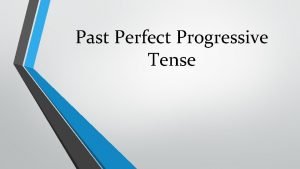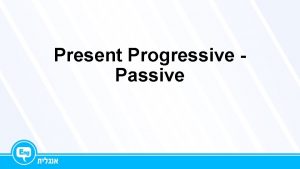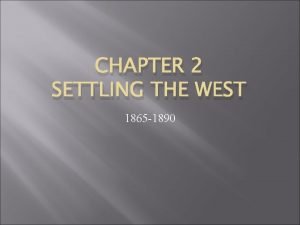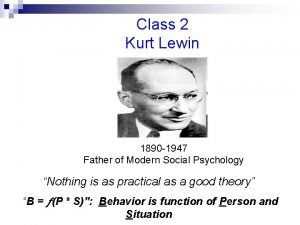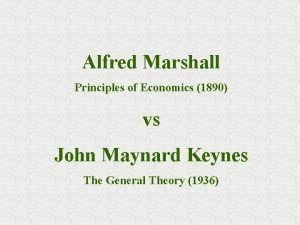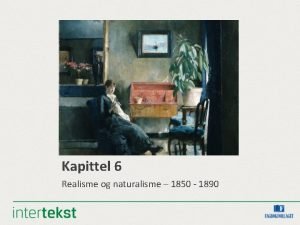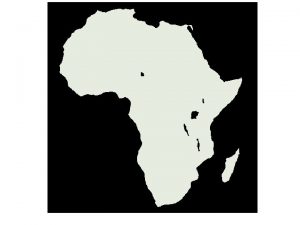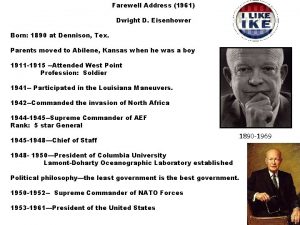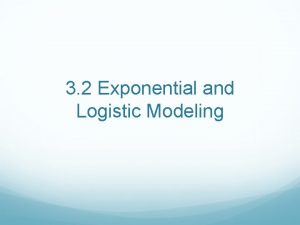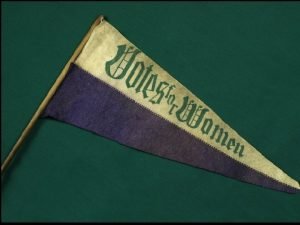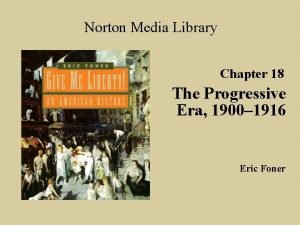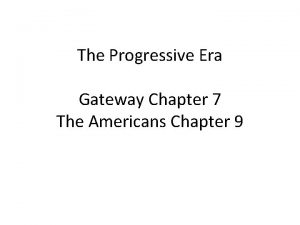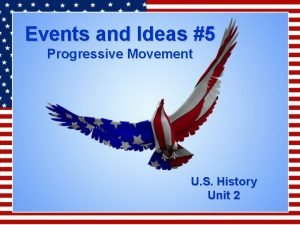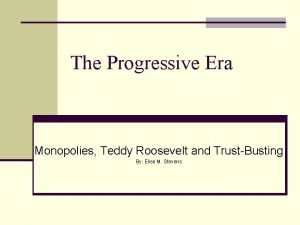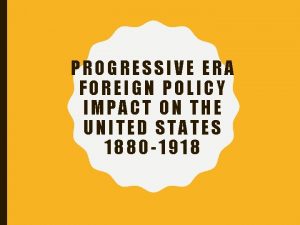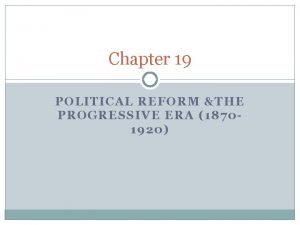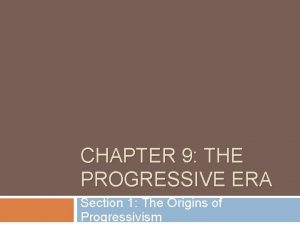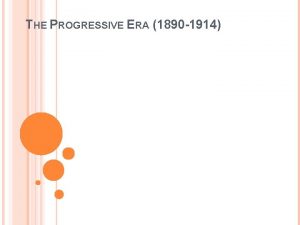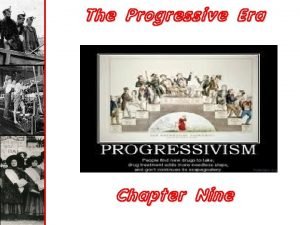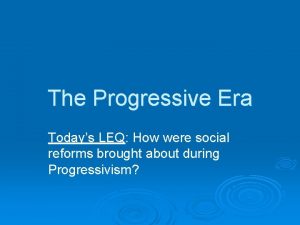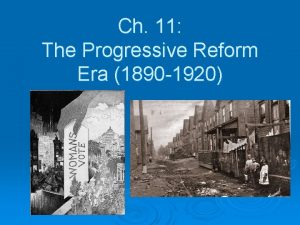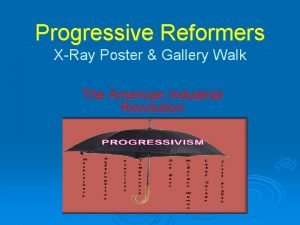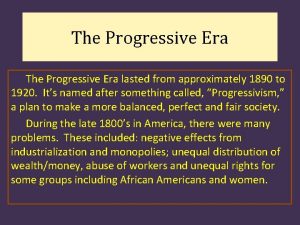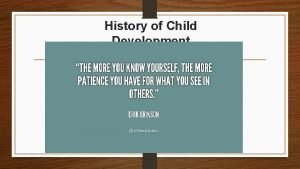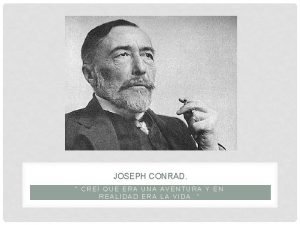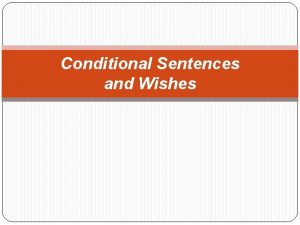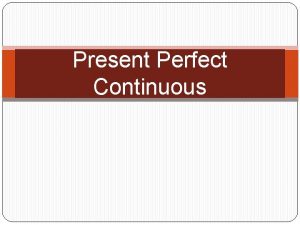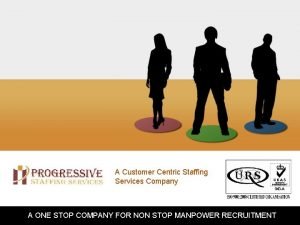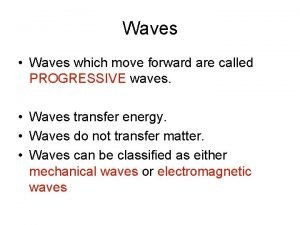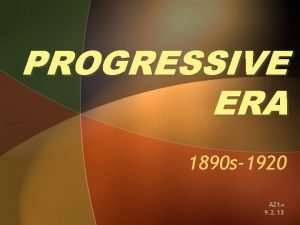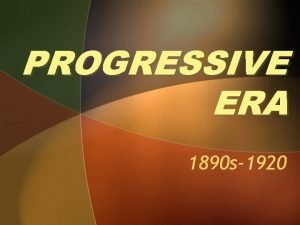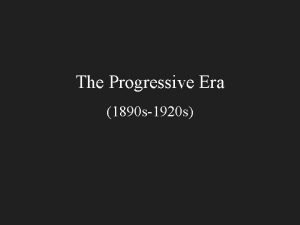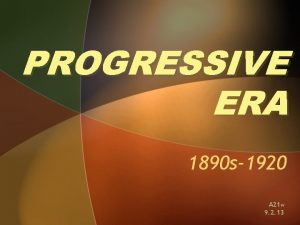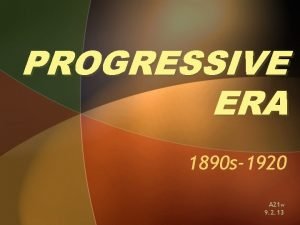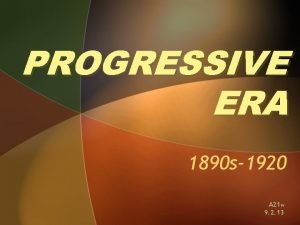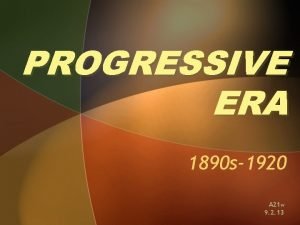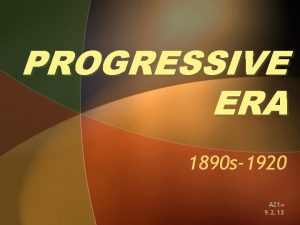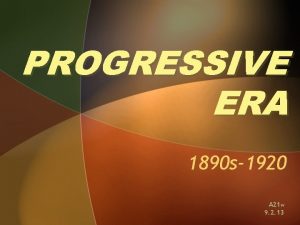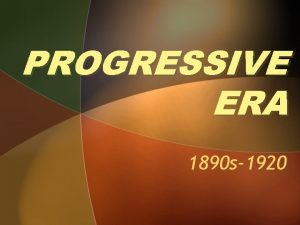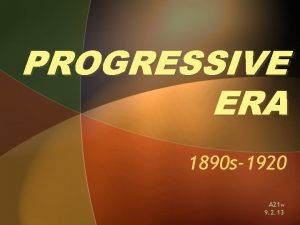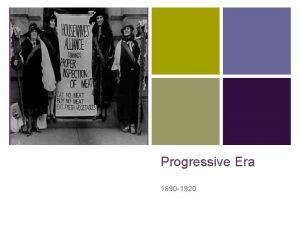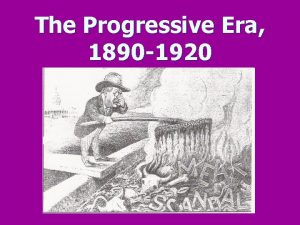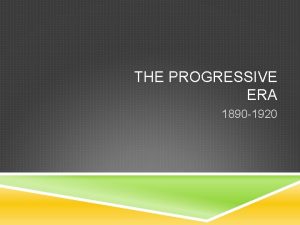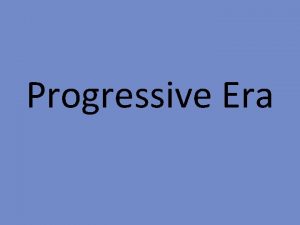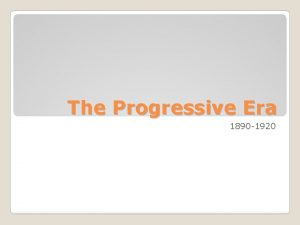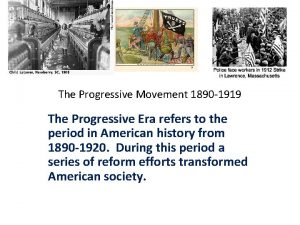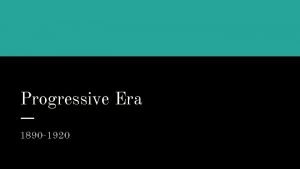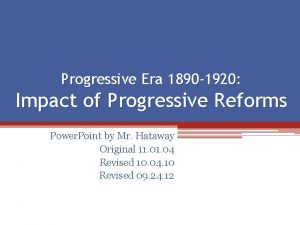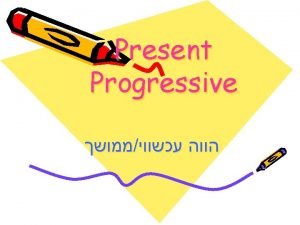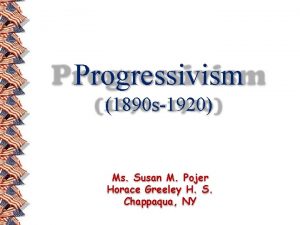PROGRESSIVE ERA 1890 s1920 A 21 w 9
















































- Slides: 48

PROGRESSIVE ERA 1890 s-1920 A 21 w 9. 2. 13

Progressivism WHEN? “Progressive Reform Era” 1890 s 1901 1917 1920 s WHO? “Progressives” – urban middle-class: managers professionals; women & WHY? Address the problems arising from: – industrialization (big business, labor strife) – urbanization (slums, political machines, corruption) – immigration (ethnic diversity) – inequality & social injustice (women & racism)

Progressivism WHAT are their goals? • • Democracy – government accountable to the people Regulation of corporations & monopolies Social justice – workers, poor, minorities Environmental protection HOW? • Government • Efficiency (laws, regulations, programs) – value experts, use of scientific study to determine the best solution

Progressivism and Its Champions • Industrialization helped many but also created dangerous working environments and unhealthy living conditions for the urban poor. • Progressivism, a wide-ranging reform movement targeting these problems, began in the late 19 th century. archives. gov

Muckrakers • Journalists called muckrakers and urban photographers exposed people to the plight of the unfortunate in hopes of sparking reform.



Reforming Society • Growing cities couldn’t provide people necessary services like garbage collection, safe housing, and police and fire protection. • Reformers saw this as an opportunity to expand public health services.

African-Americans Reform • Progressives fought prejudice in society by forming various reform groups. • Booker T. Washington • W. E. B. Du Bois • Niagara Movement • “talented tenth” • NAACP W. E. B. Du Bois Booker T. Washington

Black Population, 1920

Reforming the Workplace • By 1900, labor unions fought for adult male workers but didn’t help women and children. • Businesses fought labor laws in the Supreme Court, which ruled on several cases in the early 1900 s concerning workday length.

Workplace & Labor Reforms – eight-hour work day – improved safety & health conditions in factories – workers compensation laws – minimum wage laws – unionization – child labor laws Triangle Shirtwaist Factory Fire, 1913

Women in the Workplace • Progressives mounted state campaigns to limit workdays for women • They were successful in a few states

The Triangle Shirtwaist Company Fire In 1911, a disaster in New York inspired progressives to fight for safety in the workplace. • About 500 women worked for the Triangle Shirtwaist Company, a highrise building sweatshop that made women’s blouses.

Fire Leads to Reform • Just as they were ending their six-day workweek, a small fire broke out, which quickly spread to three floors. • Escape nearly impossible, as doors were locked • the fire escape broke • fire was too high for fire truck ladders to reach. • More than 140 women and men died in the fire

Election Reforms • Progressives wanted fairer elections and to make politicians more accountable to voters. • Some measures Progressives fought for include Direct primary: voters select a party’s candidate for public office 17 th Amendment: voters elect their senators directly initiative: allows referendum: allows citizens to propose new citizens to vote on a laws proposed or existing law secret ballot: people vote privately without fear of coercion recall: allows voters to remove an elected official from office

Theodore Roosevelt’s Square Deal The Main Idea Theodore Roosevelt used the power of the presidency to push for progressive reforms in business and in environmental policy. Reading Focus • What was Theodore Roosevelt’s view of the role of the president? • How did Roosevelt attempt to regulate big business? • What was Roosevelt’s philosophy about conserving the environment, and how did he carry out his philosophy?

Roosevelt’s View of the Presidency • Roosevelt’s rise to governor of New York upset the Republican political machine. From Governor to Vice • To get rid of the progressive Roosevelt, party President bosses got him elected as vice president, a position with little power at that time.

Unlikely President • President William Mc. Kinley was shot and killed in 1901, leaving the office to Roosevelt. • At 42 years old he was the youngest president and an avid reformer.

View of the Presidency • Roosevelt saw the presidency as a bully pulpit, or a platform to publicize important issues and seek support for his policies on reform.

The Square Deal • The Square Deal became Roosevelt’s 1904 campaign slogan and the framework for his entire presidency. • He promised to “see that each is given a square deal, because he is entitled to no more and should receive no less. ”

The Square Deal • Roosevelt’s square deal called for limiting the power of trusts, promoting public health and safety, and improving working conditions.

Regulating Big Business • Roosevelt believed big business was essential to the nation’s growth but also believed companies should behave responsibly. • He spent a great deal of attention on regulating corporations, determined that they should serve the public interest.

Upton Sinclair and Meatpacking • In 1906 Congress enacted two consumer protection laws. The Meat Inspection Act required federal government inspection of meat shipped across state lines. The Pure Food and Drug Act outlawed food and drugs containing harmful ingredients, and required that containers carry ingredient labels.

Environmental Conservation Roosevelt’s Thoughts • Recognized that natural resources were limited and that government should regulate resources • Wanted to manage public land for varied uses: some for preservation, some so make money Roosevelt’s Solution • The Newlands Reclamation Act of 1902. • allowed federal government to create irrigation projects to make dry lands productive. • During Roosevelt’s presidency, 24 reclamation projects were launched.

Taft and Wilson The Main Idea Progressive reforms continued during the Taft and Wilson presidencies, focusing on business, banking, and women’s suffrage. Reading Focus • How did Taft’s approach to progressivism split the Republican Party? • What was Wilson’s New Freedom reform plan? • How did women gain the right to vote in national elections? • How did progressivism affect African Americans?

Progressivism under Taft • President Roosevelt didn’t run for a third term, instead supporting William Howard Taft, a friend advisor who, despite a more cautious view on reform, pledged loyalty to the Roosevelt program. • Upon his election, Taft worked to secure Roosevelt’s reforms rather than build upon them.

16 th Amendment • Taft’s administration is also credited with the passage of the Sixteenth Amendment, created the income tax to pay for government programs.

Taft in Trouble • Roosevelt eventually stops supporting Taft

Taft’s Progressive Accomplishments • trust-busting • BUT: Caused split in Republican Party • forest and oil – Payne-Aldrich Tariff reserves • Sixteenth Amendment (Taft has) “…completely twisted around the policies I advocated and acted upon. ” -Theodore Roosevelt (1909) – Pinchot-Ballinger Controversy

1912 Election • The Republican party nominated President Taft • The Progressives split to form their own party, the New Progressive (“Bull Moose”) Party, with Roosevelt as its candidate.

Democrats win in 1912 • With the Republicans split, Democrat Woodrow Wilson easily took the election

Wilson’s New Freedom • Wilson, former governor of New Jersey, was a zealous reformer • During his presidential campaign, Wilson proposed a plan of reform called the New Freedom, which called for – tariff reductions – banking reform – stronger antitrust legislation.

Tariff Reduction • In October 1913, Congress passed the Underwood Tariff Act, which lowered taxes to their lowest level in 50 years.

Low Tariffs…High Taxes… • Tariff reduction=less income for govmt. , so the act also introduced a graduated income tax. • The income taxed people according to their income, and wealthy people paid more than poor or middle-class people.

Federal Reserve • President Wilson’s next target was the banking system. • bank failures were common, and banks collapsed when too many people withdrew their deposits at the same time. • People needed access to their money without fear of bank failure. • Wilson’s answer was the 1913 Federal Reserve Act, • created a central fund from which banks could borrow to prevent collapse during a financial panic.

Banking Reform • The Federal Reserve Act put the nation’s banks under the supervision of the federal government for the first time.

Stronger Antitrust Laws • Though Congress passed the Sherman Antitrust Act in 1890 to limit the power of monopolies, unfair business practices to go on. • Wilson had two solutions to these problems. Clayton Antitrust Act • Passed in 1914 • Prohibited companies from buying stock in competing companies in order to form a monopoly • Supported workers by making strikes, boycotts, and peaceful picketing legal for the first time The FTC • The Federal Trade Commission • Enforced antitrust laws and was tough on companies that used deceptive advertising










Click on the window to start video
 Function of present perfect continuous tense
Function of present perfect continuous tense What is passive
What is passive Past simple past progressive present perfect
Past simple past progressive present perfect Soddie
Soddie Riconoscimento degli oggetti
Riconoscimento degli oggetti Ang palimbagan ng el filibusterismo
Ang palimbagan ng el filibusterismo Exponential functin
Exponential functin Rizal leaves london for paris and later to brussels
Rizal leaves london for paris and later to brussels Father of social psychology
Father of social psychology Marshall keynes
Marshall keynes Titteskapsteater
Titteskapsteater Motives of old imperialism
Motives of old imperialism Magbigay ng halimbawa ng biswal na dimensyon
Magbigay ng halimbawa ng biswal na dimensyon Naglimbag ng noli me tangere
Naglimbag ng noli me tangere 1890'lı yıllarda ingiltere'de whiff
1890'lı yıllarda ingiltere'de whiff 1890 computer
1890 computer Kirjanik 1890-1952
Kirjanik 1890-1952 Born 1890
Born 1890 The population of smallville in the year 1890 was 6250
The population of smallville in the year 1890 was 6250 Progressive era
Progressive era Chapter 18 the progressive era
Chapter 18 the progressive era Gateway to us history chapter 7 the progressive era
Gateway to us history chapter 7 the progressive era Progressive era worksheets
Progressive era worksheets Progressive era monopolies
Progressive era monopolies Dollar diplomacy pros and cons
Dollar diplomacy pros and cons Chapter 19 political reform and the progressive era
Chapter 19 political reform and the progressive era Chapter 9 the progressive era section 1 answers
Chapter 9 the progressive era section 1 answers When was the progressive era? *
When was the progressive era? * What scandalous practices did upton
What scandalous practices did upton Wizard of oz progressive era
Wizard of oz progressive era Njctl math
Njctl math Progressive era leq
Progressive era leq Chapter 11 the progressive reform era
Chapter 11 the progressive reform era Progressive era posters
Progressive era posters Staar review games
Staar review games The progressive era lasted from
The progressive era lasted from John dewey progressive era
John dewey progressive era What is muckraking journalism
What is muckraking journalism Era uma estrela tão alta era uma estrela tão fria
Era uma estrela tão alta era uma estrela tão fria Era quiz: the baroque era
Era quiz: the baroque era Elizabethan vs victorian
Elizabethan vs victorian Creí que era una aventura y en realidad era la vida
Creí que era una aventura y en realidad era la vida Conditional sentences and wishes
Conditional sentences and wishes Past progressive ring
Past progressive ring Have has ving
Have has ving Progressive staffing solutions
Progressive staffing solutions Reir present progressive
Reir present progressive Progressive waves travelling disturbances that transfer
Progressive waves travelling disturbances that transfer Present continuous structure
Present continuous structure
